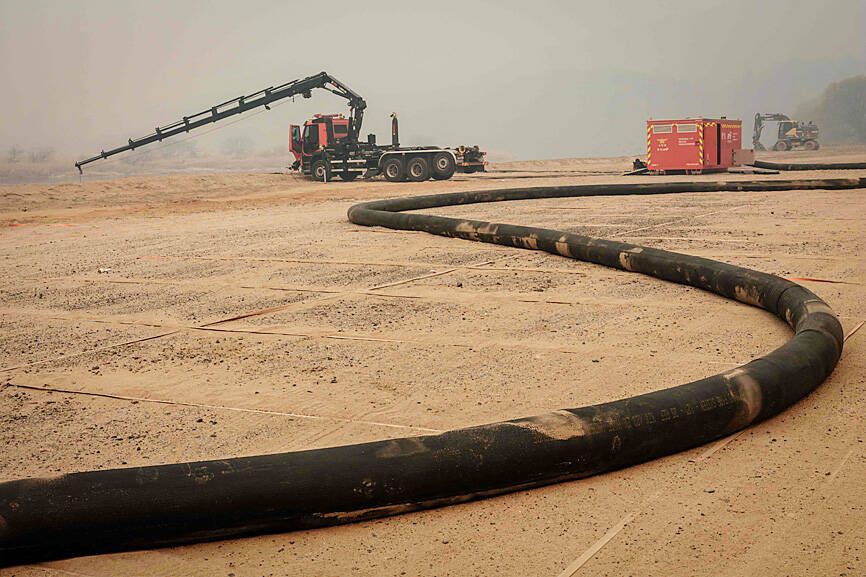Wind-driven wildfires that were among South Korea’s worst ever have ravaged the country’s southern regions, killing 24 people, destroying more than 200 structures and forcing 27,000 residents to evacuate, officials said yesterday.
The death toll included a pilot who died after a helicopter crashed during efforts to contain a blaze in the southeastern town of Uiseong, one of the hardest-hit areas.
The aircraft had no other crew members.

Photo: AFP
Police said that most of the dead were in their 60s or 70s.
The South Korean National Fire Agency said at least 26 people sustained varying degrees of injuries.
An ancient Buddhist temple, houses, factories and vehicles were destroyed in the wildfires, which had burned 17,535 hectares, the government’s emergency response center said.
In a televised address, Acting South Korean President Han Duck-soo said that the wildfires that began on Friday last week were worse than many previous ones.
“Damage is snowballing,” Han said. “There are concerns that we’ll have wildfire damages that we’ve never experienced, so we have to concentrate all our capabilities to put out the wildfires in the rest of this week.”
Han said that crews struggled to extinguish the wildfires because strong winds swept the areas overnight.
He also said about 4,650 firefighters, soldiers and other personnel were working yesterday with the help of about 130 helicopters, adding that “a small amount” of 5mm to 10mm of rain was expected today.
As of Wednesday evening, firefighters were tackling at least four wildfires, including in the southeastern coastal town of Yeongdeok, which alerted residents of the nearest village to evacuate to an indoor gymnasium.
Strong winds and smoke-filled skies forced authorities in the southeastern city of Andong to order evacuations from two villages, including Puncheon, home to the Hahoe folk village — a UNESCO World Heritage Site founded in the the 14th or 15th century.

SECURITY: As China is ‘reshaping’ Hong Kong’s population, Taiwan must raise the eligibility threshold for applications from Hong Kongers, Chiu Chui-cheng said When Hong Kong and Macau citizens apply for residency in Taiwan, it would be under a new category that includes a “national security observation period,” Mainland Affairs Council (MAC) Minister Chiu Chui-cheng (邱垂正) said yesterday. President William Lai (賴清德) on March 13 announced 17 strategies to counter China’s aggression toward Taiwan, including incorporating national security considerations into the review process for residency applications from Hong Kong and Macau citizens. The situation in Hong Kong is constantly changing, Chiu said to media yesterday on the sidelines of the Taipei Technology Run hosted by the Taipei Neihu Technology Park Development Association. With

A US Marine Corps regiment equipped with Naval Strike Missiles (NSM) is set to participate in the upcoming Balikatan 25 exercise in the Luzon Strait, marking the system’s first-ever deployment in the Philippines. US and Philippine officials have separately confirmed that the Navy Marine Expeditionary Ship Interdiction System (NMESIS) — the mobile launch platform for the Naval Strike Missile — would take part in the joint exercise. The missiles are being deployed to “a strategic first island chain chokepoint” in the waters between Taiwan proper and the Philippines, US-based Naval News reported. “The Luzon Strait and Bashi Channel represent a critical access

CARROT AND STICK: While unrelenting in its military threats, China attracted nearly 40,000 Taiwanese to over 400 business events last year Nearly 40,000 Taiwanese last year joined industry events in China, such as conferences and trade fairs, supported by the Chinese government, a study showed yesterday, as Beijing ramps up a charm offensive toward Taipei alongside military pressure. China has long taken a carrot-and-stick approach to Taiwan, threatening it with the prospect of military action while reaching out to those it believes are amenable to Beijing’s point of view. Taiwanese security officials are wary of what they see as Beijing’s influence campaigns to sway public opinion after Taipei and Beijing gradually resumed travel links halted by the COVID-19 pandemic, but the scale of

Pope Francis is be laid to rest on Saturday after lying in state for three days in St Peter’s Basilica, where the faithful are expected to flock to pay their respects to history’s first Latin American pontiff. The cardinals met yesterday in the Vatican’s synod hall to chart the next steps before a conclave begins to choose Francis’ successor, as condolences poured in from around the world. According to current norms, the conclave must begin between May 5 and 10. The cardinals set the funeral for Saturday at 10am in St Peter’s Square, to be celebrated by the dean of the College